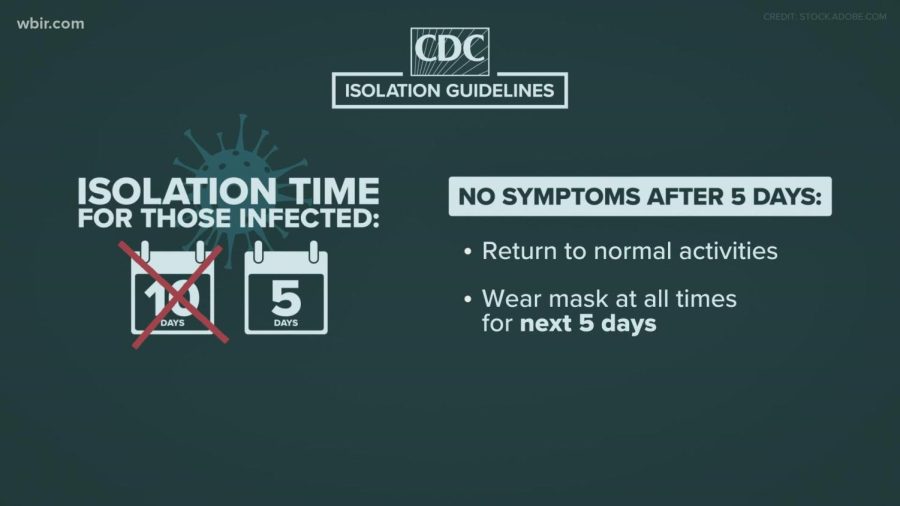New CDC Guidelines: The Priority of Productivity
Why prioritizing getting people back to work is detrimental to ending the pandemic, and how capitalism is favored over the well-being of the American people.
Far too often, during the nearly two-year-long pandemic, were the safety and needs of employees overlooked in favor of company productivity. When America’s supermarket cashiers, retail workers, fast food employees, and airline staff were deemed “essential workers” at the beginning of the pandemic, formerly “unimportant” jobs were appreciated more than ever. However, as the pandemic progressed, the more corporations and businesses forced their employees back into the workplace despite the looming risk of COVID-19, the more these so-called “essential” workers seemed and felt disposable.
This humanitarian issue was especially evident after the CDC (Center for Disease Control) released new guidelines for employees returning to work after contracting the virus. The 10-day waiting period after initially testing positive was changed to a 5-day waiting period, based mainly on the notion that symptoms will be unnoticeable after 5 days. However, this logic is deeply flawed. For starters, There is also no guarantee that those within the establishment, including the employees and their employers will do their part to ensure that the workplace is as safe as it could be. It has been a running trend for companies and businesses to be incredibly lenient when it comes to mask mandates in specific, and when the CDC’s new guidelines rely on the infected to continue to wear a mask after the alleged 5-day waiting period, there is absolutely no guarantee that countless people won’t be exposed.
While the CDC moving forward with their new guidelines has specifically caught the eye of the public, this is not the first time that regulations have been put in place by corporations to ensure that capitalism is prioritized, and productivity, maximized. For example, Amazon workers have been known to be mistreated in favor of getting products out quickly, from being given back-breaking tasks to having bathroom breaks withheld. The grueling, often 12-hour long workdays are accompanied by constant surveillance to ensure that employees are staying “on-task”, and while you would think this would yield a reasonable profit at the very least, there have been multiple allegations that prove otherwise. According to several Amazon employees, the company has been shortchanging its staff on their paychecks.
One specific case of this misconduct was featured in The New York Times at the end of October 2021. It featured Tara Jones, a mother employed at Amazon, who realized that $90 was missing from her paycheck. Although she reported this issue, she noticed the same thing occurring again and again. Jones’ investigation into why her paychecks were cut short revealed countless parents, patients with medical emergencies, and those vulnerable to an income decrease who had also been experiencing the same thing – for nearly a year and a half.
This dangerous misconduct from the company has regularly gone unchecked. It has only been brought to light by employees such as Tara Jones, who have bravely stepped forward with their stories of abuse and exploitation. It is definitely not news that multi-million dollar corporations such as Amazon can afford to mistreat their employees, especially when they see them as disposable, or simply as a way to make them more money. This has only been heightened by the pandemic, when the problem should have been solved before the financially vulnerable faced even more adversities.
Although the exploitation of low-wage workers is not a new concept, it seems to be emphasized by the CDC’s 5-day guidelines, encouraging workers to head back into the field without taking their health into consideration. I have personally seen the effects of this in my hometown, with businesses such as grocery stores, restaurants, and locally owned establishments being run almost exclusively by young people. More often than not, my peers were seen on the “front-lines” of the pandemic, working up to 40 hours a week to keep our little town running when it mattered the most.
I spoke to Sarah Mason (12), an employee at the local Kroger. I inquired about how it felt to be deemed an essential worker at the age of 17, and what working through a pandemic looked like. “I really think it is mind-boggling that I, a 17-year-old high school student, am being considered an essential worker,” said Mason. “I think the term essential worker puts a lot of pressure on the people who did continue working during the pandemic. You’re expected to come to work during unsafe times and help other people when there often isn’t anyone to help you.” Mason finished speaking on her experience by thanking Kroger for assisting their essential workers in the little ways they did.
The exploitation of employees, no matter how young or vulnerable, is everywhere you look nationwide. Although there are experiences such as Mason’s where corporations do what they can to assist their workers, safety is hardly ever prioritized in a work environment, from local businesses to large corporations. What is prioritized, however? Capitalism. And it will continue to be until the well-being of the employees behind the businesses is emphasized in a way that matters.

Lily Savage is a senior this year at Woodford County High School. This is her fourth and last year writing for The Jacket Journal, and she is thrilled...











